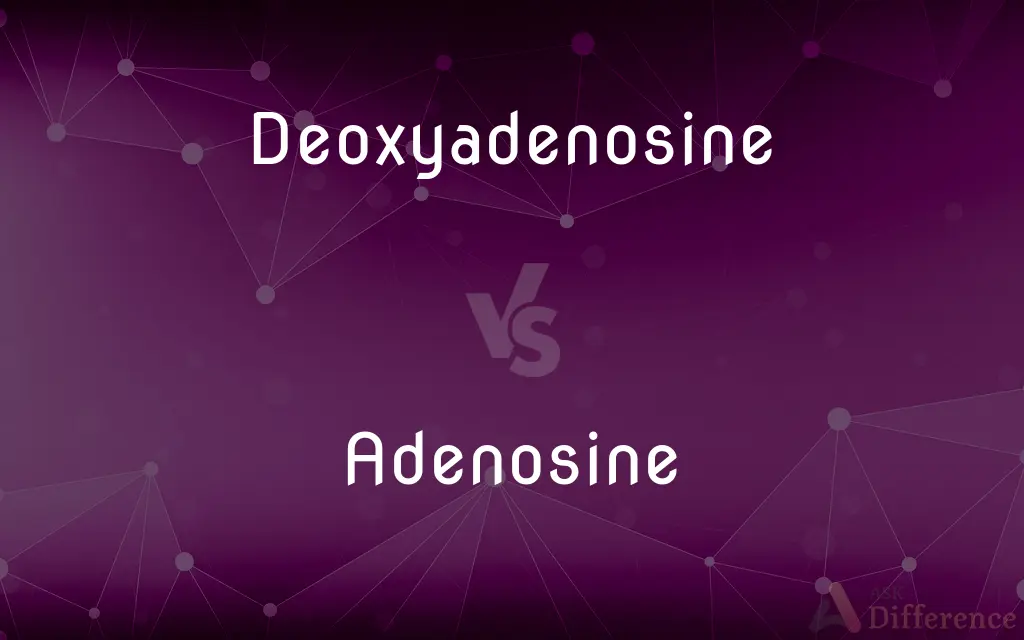Deoxyadenosine vs. Adenosine — What's the Difference?
By Maham Liaqat & Fiza Rafique — Updated on April 16, 2024
Deoxyadenosine is a nucleoside lacking an oxygen molecule at the 2' carbon in its sugar component, while adenosine includes this oxygen, impacting their functions in DNA and RNA respectively.

Difference Between Deoxyadenosine and Adenosine
Table of Contents
ADVERTISEMENT
Key Differences
Deoxyadenosine is a component of DNA, crucial for storing genetic information, whereas adenosine is primarily found in RNA, playing a vital role in protein synthesis. This structural difference is key to their distinct biological roles.
Deoxyadenosine lacks an oxygen atom at the 2' position of its ribose sugar, which makes DNA more chemically stable. On the other hand, adenosine contains this oxygen atom in RNA, making it more reactive and suitable for protein synthesis.
In terms of biological processes, deoxyadenosine is involved in DNA replication and repair mechanisms. In contrast, adenosine participates in numerous cellular processes, including energy transfer as ATP and signaling as cyclic AMP.
The therapeutic uses of deoxyadenosine and adenosine also differ; deoxyadenosine derivatives are used in antiviral and anticancer therapies, whereas adenosine is used in treating certain types of cardiac arrhythmias due to its effects on heart rhythm.
Regarding metabolic pathways, deoxyadenosine is metabolized primarily through deamination, leading to deoxyinosine. Adenosine, however, is broken down into inosine by adenosine deaminase, which plays a critical role in purine metabolism.
ADVERTISEMENT
Comparison Chart
Presence of Oxygen
Lacks oxygen at 2' carbon of ribose
Contains oxygen at 2' carbon of ribose
Role in Genetic Material
Component of DNA
Component of RNA
Stability
More stable chemically
Less stable, more reactive
Common Uses
Antiviral and anticancer therapies
Treatment of cardiac arrhythmias
Metabolic Pathway
Metabolized to deoxyinosine
Metabolized to inosine
Compare with Definitions
Deoxyadenosine
A nucleoside integral to DNA structure.
Deoxyadenosine pairs with thymine in the DNA helix.
Adenosine
A nucleoside that forms part of RNA.
Adenosine binds with uracil during RNA transcription.
Deoxyadenosine
Involved in DNA stability.
Deoxyadenosine contributes to the chemical resilience of DNA.
Adenosine
Used in cardiac therapy.
Adenosine is administered to manage supraventricular tachycardia.
Deoxyadenosine
Subject to metabolic deamination.
Deoxyadenosine is converted into deoxyinosine during metabolism.
Adenosine
Degraded by adenosine deaminase.
The enzyme adenosine deaminase converts adenosine into inosine.
Deoxyadenosine
Absent in RNA.
Unlike adenosine, deoxyadenosine is not found in RNA molecules.
Adenosine
Active in cellular energy transactions.
Adenosine triphosphate (ATP) is a key energy carrier in cells.
Deoxyadenosine
Utilized in medical treatments.
Deoxyadenosine analogs are used in cancer therapy.
Adenosine
Essential for protein synthesis.
Adenosine's presence in RNA facilitates the production of proteins.
Deoxyadenosine
Deoxyadenosine (symbol dA or dAdo) is a deoxyribonucleoside. It is a derivative of the nucleoside adenosine, differing from the latter by the replacement of a hydroxyl group (-OH) by hydrogen (-H) at the 2′ position of its ribose sugar moiety.
Adenosine
Adenosine is an organic compound that occurs widely in nature in the form of diverse derivatives. The molecule consists of an adenine attached to a ribose via a β-N9-glycosidic bond.
Deoxyadenosine
(biochemistry) A deoxyribonucleoside related to adenosine
Adenosine
A nucleoside, C10H13N5O4, that is composed of adenine linked to ribose, is a component of nucleic acids and of ADP, AMP, and ATP, and plays a role in regulating various physiological functions.
Deoxyadenosine
A nucleoside component of DNA; composed of adenosine and deoxyribose
Adenosine
A nucleoside derived from adenine and ribose, found in striated muscle tissue.
Adenosine
(biochemistry) a nucleoside that is a structural component of nucleic acids; it is present in all living cells in a combined form as a constituent of DNA and RNA and ADP and ATP and AMP
Common Curiosities
Where is deoxyadenosine primarily found in biological systems?
Deoxyadenosine is primarily found in DNA.
How does the lack of an oxygen atom affect deoxyadenosine's function?
The absence of an oxygen atom makes deoxyadenosine more chemically stable, suitable for long-term genetic information storage.
Can deoxyadenosine be found in RNA?
No, deoxyadenosine is exclusive to DNA, not RNA.
What is the main structural difference between deoxyadenosine and adenosine?
Deoxyadenosine lacks an oxygen molecule at the 2' carbon of its ribose sugar, unlike adenosine.
How are deoxyadenosine and adenosine metabolized in the body?
Deoxyadenosine is metabolized to deoxyinosine, while adenosine is converted to inosine.
What roles does adenosine play in cellular processes?
Adenosine is involved in protein synthesis, energy transfer as ATP, and signaling as cyclic AMP.
What are the therapeutic uses of adenosine?
Adenosine is used in the treatment of some types of cardiac arrhythmias.
How does the structure of deoxyadenosine contribute to its function in DNA?
Its chemical stability due to the lack of an oxygen atom at the 2' carbon enhances its suitability for storing genetic information.
What is the significance of deoxyadenosine in DNA?
Deoxyadenosine forms part of the backbone of DNA, crucial for its structure and integrity.
How are the roles of deoxyadenosine and adenosine in cellular metabolism different?
Deoxyadenosine is primarily involved in genetic functions and stability, while adenosine plays broader roles including protein synthesis and energy management.
Why is adenosine more reactive than deoxyadenosine?
The presence of an oxygen molecule at the 2' carbon makes adenosine more reactive.
Is adenosine ever used in DNA?
No, adenosine is not used in DNA; it is a key component of RNA.
What medical treatments involve deoxyadenosine?
Deoxyadenosine is used in antiviral and anticancer therapies.
What is the impact of adenosine in energy transfer within cells?
Adenosine forms adenosine triphosphate (ATP), which is vital for energy transfer in cells.
Can adenosine affect heart rhythm?
Yes, adenosine can be used to regulate heart rhythm in certain medical conditions.
Share Your Discovery

Previous Comparison
Tease vs. Bait
Next Comparison
Sushi vs. MakiAuthor Spotlight
Written by
Maham LiaqatCo-written by
Fiza RafiqueFiza Rafique is a skilled content writer at AskDifference.com, where she meticulously refines and enhances written pieces. Drawing from her vast editorial expertise, Fiza ensures clarity, accuracy, and precision in every article. Passionate about language, she continually seeks to elevate the quality of content for readers worldwide.
















































